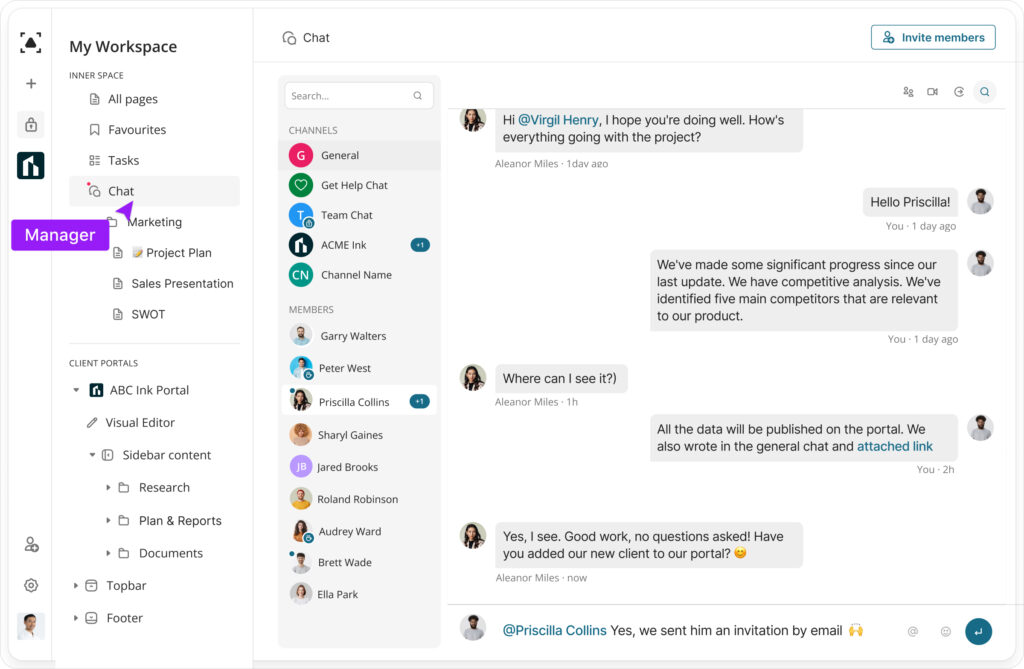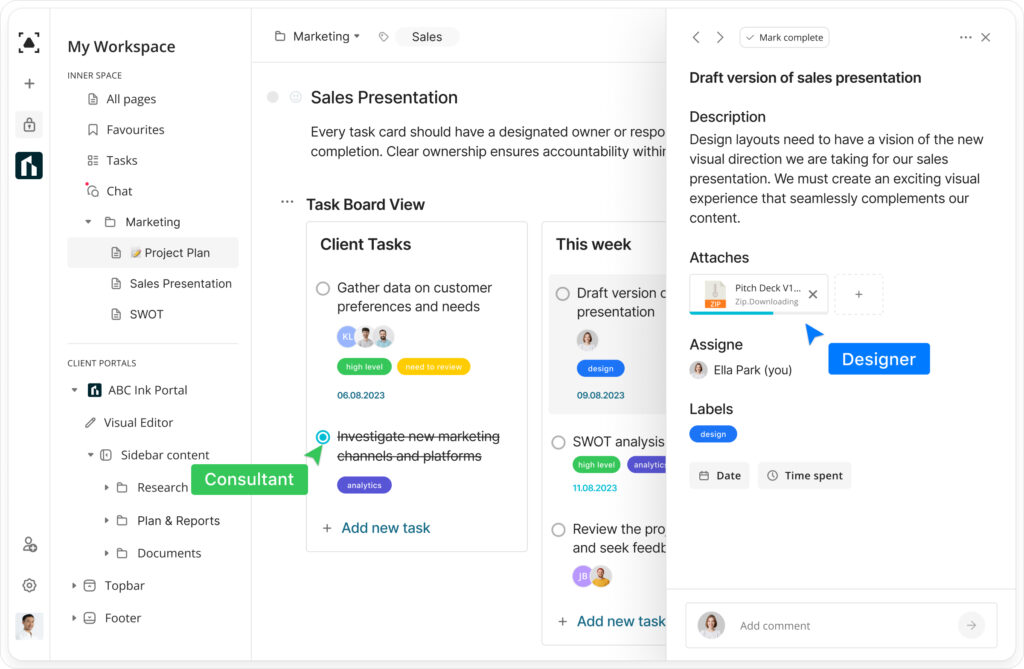
Efficient Team Communication: Utopia or Reality?
- September 29, 2023
- 19 Min read
Effective team communication in the workplace is critical to a company’s overall success. Communication is vital to keeping the peace and working together productively in any relationship or context, whether professional or personal. The reception people give to what you say depends on both the content and the context in which you say it.
Successful teams can communicate effectively and work together. Working in a hybrid or remote office is tough for team communication, but companies must find solutions to this root problem.
The new ways of working are here to stay. Many teams must convert from synchronous to asynchronous communication and discover strategies to get the most out of the new ways of working.
What Is Team Communication?
Today, teams are a prevalent type of structure in enterprises. Teams are often regarded as one of the most efficient and successful means of accomplishing organizational objectives and goals. Teamwork emphasizes problem-solving rather than individual effort. Specific protocols govern team members’ social and professional interactions — they function interdependently.
Teams should emphasize communication tactics that help them operate more effectively together. Employees may participate more actively and advance in their roles as a result.
When it comes to working together as a team, how do we define good communication?
Information and ideas are sent from one person to another.
When we talk about team communication, we’re referring to how team members engage with one another, the normative social behaviors of a team (such as sharing information, expressing feelings, resolving conflicts and so on), and the means through which these interactions occur.
In addition, communication conveys information and ideas from one person to another. This kind of interaction is known as “team communication” between groups. It is crucial to master the art of team communication to work together efficiently.
How does Effective Team Communication Work?
In a team setting, it is crucial to share knowledge. But everyone who has ever tried to give another person instructions or provide them with information via a third party knows how easy it is for information to be miscommunicated and ideas to be misconstrued.
The need for effective team communication in any thriving business becomes readily apparent when we extrapolate the challenges of interpersonal communication to disseminate information across a whole team.
Your ability to effectively convey information to and receive feedback from team members (and vice versa) is a significant contributor to the high quality of work you routinely produce.
Achieving team success is facilitated by open and honest communication among team members. It also increases participation, improves team communication, bonds coworkers, and encourages a feeling of community.
Most CEOs feel that regular feedback and check-ins from colleagues are crucial to achieving goals. Workers who believe their opinions matter are almost five times more likely to be motivated to give their all on the job.
With more people than ever before working from home, it’s more important to foster a culture of constant communication and teamwork to achieve common goals. Let’s go a bit more into why and how effective team communication is crucial to maximizing the benefits of teamwork.
Having trouble communicating as a team
Daily encounters provide the groundwork for outstanding cooperation, communication and the synergistic advantages that flow from it. It is always simpler to share the burden, get more perspectives and do better work when collaborating and communicating with people in any field.
However, effective team communication isn’t always accessible, particularly when different perspectives, methods of operation and personalities are at play. A good grasp of what constitutes efficient team communication and the availability of appropriate tools are required.
When the team members you rely on to find daily solutions feel safe enough to offer their views, ideas and opinions openly and respectfully, you’ll know you’re on your way to successful team communication.
Is there a direct link between excellent team communication and increased productivity?
Improving the team’s communication ability will likely lead to more success.
There is a correlation between a high level of trust in the workplace and increased productivity, enthusiasm and teamwork. Trust is built through open, honest communication in a brick-and-mortar office or online. Team members are more likely to have pleasant encounters if they know they can depend on one another to be fair and helpful in their words and actions.
What’s the result?
Teams with solid communication:
- Learn to value one another’s unique abilities, quirks and methods of operation.
- Enhance the ability to plot out and execute collective objectives.
- Learn to take more pride in their work.
The ability of a team to communicate effectively is essential for many reasons beyond just dividing tasks and finding solutions. Acknowledging and cheering for one another out loud is also part of this.
We raise the bar on the quality of our relationships with one another and, by extension, our team’s performance when we take the time to recognize, encourage and reach out to our colleagues for success in the face of adversity.
Dispersed teams that participate in virtual interactions as part of a flexible work environment place a premium on effective communication. Numerous organizations claim to have faced many challenges in establishing remote team communication.
Some of the difficulties in communicating that have become apparent due to the rise of remote work are as follows.
- Reasons for working together across many time zones
- Facilitating adequate dialogue to forestall confusion and misunderstanding
- Preventing mental overload from too many meetings or messages
- Problems with modern technology (including training deficiencies and using the wrong tools)
It is impossible to stress the significance of effective remote team communication.
While team members aren’t in the same physical location, there’s a greater chance that they’ll each do one of the following when working remotely:
- Misunderstand or ignore the larger context of everyday communication
- Feel alienated from coworkers and the shared objectives they all have
- Decrease the effectiveness of preparation and execution of a project
You’ll need to master new team communication norms and techniques to bring together and maintain an online team.
Maximizing the efficiency of your online team conversations
Imagine the standard methods of office communication. We communicate through memos, instructions and shared checklists. We coordinate schedules over the phone, meet in conference rooms and chat in the halls.
The digital equivalent of any form of team communication, written or spoken, is available in a virtual environment.
A team’s success hinges on its ability to choose and consistently use channels of communication that:
- Make time for team members who live in various time zones
- Allow for a wide range of methods of expression and approaches to tasks
- Create as few barriers as possible between the team and individual communication
Finding a happy medium in your online communication is essential.
Encourage cultural interaction and information exchange among all team members. Give people enough communication freedom so they aren’t constantly bombarded with notifications. They need the alone time to get their work done.
Remember that how you reach out to, stay in contact with and communicate with your team may significantly impact individual productivity and performance.
Why Improving Team Communication Matters

Without effective team communication, conflicts, tensions and misunderstandings are more likely to arise in the workplace. Effective communication is the bedrock of a thriving culture and a well-oiled team. When a team has strong lines of communication, the company benefits; on the other side, if a team has trouble communicating, it is doomed to struggle or perhaps even fail. Effective team communication plays a crucial role in the global work atmosphere and has a list of positive influence factors. It is the responsibility of employers to facilitate and maintain the interest of their remote employees.
This then begs the question: what are the most significant advantages of effective communication inside and across teams in an organization?
Increase participation among team members
When team members can express their thoughts and ideas clearly and work together toward a common goal, they are more likely to feel invested in their work and satisfied with their jobs. Employees will care about a company’s success when they have opportunities to engage with and learn from their coworkers, thus improving team communication. Team members get involved in work activities more gladly when they have a firm grasp of their responsibilities and understand what is expected.
Increasing teamwork and output in the workplace
Good team communication fosters productive cooperation and creates a positive team dynamic. Workers that can read one another’s nonverbal cues will have a much easier time collaborating and avoiding unnecessary conflicts. Employees must work together to get things done and communicate effectively.
Facilitating accomplishments
Teams with solid lines of communication tend to be more nimble. They are more effective because of their increased agility in changing market conditions, routine difficulties and bottlenecks. Having even a single highly engaged worker in a team may significantly impact the level of enthusiasm and productivity of the whole group and team communication in general.
Accurate and efficient team communication boosts productivity, allowing businesses to adopt plans more efficiently, reach goals and expand toward their intended objectives. Businesses may simplify tasks to communicate and collaborate toward shared objectives with far more ease when all employees are on the same page, thanks to effective communication techniques. Disorganization, misunderstandings, miscommunication and other problems that hinder an organization’s progress toward its objectives might arise when team members fail to keep in touch with one another.
Enhanced capacity for problem-solving
How well we communicate with one another is crucial to our success in working through shared challenges. Framing a problem precisely and collaborating with colleagues to develop a workable solution is critical to any company. When team members can express their perspectives and share their specific areas of expertise, the resulting synergy may significantly improve their ability to carry out their goals and communicate effectively.
More effective means of resolving conflicts
It doesn’t matter how harmonious a team is; disagreements will always happen. The problem is exacerbated when employees cannot express their concerns or express themselves, leading to increased stress or antagonism at work and worsening team communication. Team members will be better able to resolve disagreements in the workplace if they know how to talk to one another about them. Some workers may be more forthright and aggressive than others, while other team members may want to avoid any potential tension. To positively impact your team, you must learn to communicate effectively with others.
Improved way of team communication
Remember that the effectiveness of a team depends on its members’ ability to communicate effectively. Teams may stay engaged and on the same page via regular communication channels, including one-on-one meetings and other two-way feedback opportunities. Quality communication occurs when team members listen attentively, choose their words and express themselves clearly. When working in teams, it’s important to remember that non-verbal cues like eye contact, facial expressions and body language may strengthen or weaken a discourse. An organization’s culture may be shaped significantly by increasing the amount and quality of team communication and paying attention to nonverbal cues.
10 Best Strategies to Improve Communication With Team Members
Having discussed the challenges and benefits of team communication, we’ll explain how to improve it.
Effective communication and teamwork are inextricably intertwined. When a business places a premium on team building and provides workers with opportunities to communicate with each other and the organization, it increases the likelihood that they will work together effectively. Here are some suggestions to help your team communicate more effectively:
1. Initiate more honesty and openness
The value of communication in cooperation stems from the fact that it allows for open and frank discussions, which helps to create trust. Team members will feel more confident in their jobs and as a team when they can raise concerns, seek clarification when needed and have faith in their leaders.
2. Considering everyone’s point of view is essential
Effective communication requires a willingness to listen to and consider the perspectives of others, even if they differ from yours. Employees are more likely to speak out, listen to one another and work together in a respectful environment. The team will benefit from a less tense, more cheerful and inviting atmosphere if team members can communicate freely and express themselves with mutual respect.
3. List the responsibilities of each party
With everyone on the team knowing their responsibilities, the team is more likely to achieve its goals. When workers know what is expected, they are more likely to work together, boosting productivity and improving team communication styles. Any project or team’s objectives, timelines and milestones must be conveyed effectively.
Determine who needs to be kept apprised of progress by reviewing the defined objectives, deadlines and milestones list. Once you’ve established your team, you must keep them in the loop about any changes to the project’s goals, deadlines or significant milestones as soon as possible. High-quality project management or staff intranet software may facilitate tangible updates and improve team communication.
4. Let there be a two-way exchange of information
There may be occasions when you need to address a complex problem. One-on-one conversations are typically the most efficient and effective strategy to prevent misunderstandings or miscommunication and save time in such circumstances. “Great teams communicate equally,” says David Burkus. You may show your audience that you respect their time by setting up a face-to-face meeting, phone call or online video chat. You may learn more about the other person’s viewpoint by receiving more candid feedback in this communication.
Managers should constantly be open to hearing from their team members and consider their suggestions when making decisions. The likelihood that issues will be handled and concerns will be addressed increases when workers are provided a forum to voice their concerns or doubts to management. If managers don’t get their team’s perspectives, problems may fester and worsen. Since this is the case, it is clear that two-way feedback plays a crucial role in sustaining competent team communication.
5. Make teamwork a top priority
Team-building exercises and social gatherings allow workers to get better acquainted with one another and foster stronger bonds outside the workplace. Informal communication between employees may encourage a more cohesive and trusting organizational culture. There are abundant creative options for team-building communication exercises, no matter the group’s size.
6. Embrace a routine
Find a rhythm that works for you and your team, and make time for regular, open dialogue. You may establish daily check-ins, weekly one-on-ones and monthly or bimonthly all-team meetings to encourage these interactions and communication. Every session is a chance for workers and team managers to ask questions, discuss ways to improve and work toward a common goal.
7. Feelings of compassion should be exercised
“Being kind to each other opens lines of communication, encourages inclusion, and perpetuates empathy,” says Clark Sweat, the Forbes Councils Member. When communicating with the team members, putting yourself in their shoes and tailoring your approach to suit their preferences is essential. By keeping these things in mind before starting a conversation, you can tailor your words and tone to fit others’ preferences and ensure that you both get the most out of it.
8. Show the way
Follow your advice. If you want your staff to start using more effective methods of communication, you need to set a good example. A leader’s job is to ensure the success of their team and organization, and they can only accomplish this if they exhibit the qualities that they value in their followers. When workers see their superiors fostering an open and honest communication style, they are more likely to do the same.
9. Communicating with a clear goal in mind
Quantity does not equal quality when it comes to team communication. Every meeting should have a precise aim so that you can avoid meaningless or damaging dialogue. Arrangements should be brief. Keep them within 50 minutes so that people may relax and go back to work afterward. Ensure that only essential team members are invited. Build a comprehensive plan and distribute it to everyone in attendance before the meeting. Make it clear for the team where and when to meet, whether in a physical location or through an online communication application. Incorporate any high-priority off-topic topics discussed onto the agenda for the next meeting. When your current appointment is over, schedule the next one.
10. Reliable routes
To keep in touch with your team, whether they are located in an actual office or online, you may use any number of communication methods, including:
- Telephone conversations
- Instant messages
- Real-time video conferencing
- Collaborative Tools
There are a lot of practical communication applications nowadays that can significantly simplify the work of a remote team (Zoom, Skype, Google Docs, FuseBase, etc.). Use them to increase team communication efficiency. Make sure everyone knows the meeting’s selected mode of communication and how to join it, such as whether or not they need to download a specific app. Remember your message’s context, audience and goals when choosing your channel. Then, while talking, use language that is straightforward to grasp. You should also avoid utilizing inside jokes or group-specific language when dealing with a group that includes individuals outside your core team.
Try FuseBase to connect with your remote team as if you are in the same office
Making Team Communication More Efficient With the Right Technology
Workplace communication has evolved significantly in the last decade. A linked workplace has replaced the days of fax machines, phones and notes. This enables near-constant accessibility and input. The use of office communication technology has been met with praise and tolerance, but it can significantly enhance team communication when used well.
The role of instant messaging in the modern office

There was a time not that long ago when workers were utterly cut off from the office after they departed. Technological advancements have revolutionized workplace communication, influencing how we interact on the clock and after hours.
Many businesses have adjusted to accommodate modern communication, technological knowledge and ease. With the proliferation of IM and video chat, even email has become antiquated. As more and more of our work is preserved digitally in the cloud rather than in piles on desks, the use of printers is declining.
Whether for better or worse, these shifts have affected team communication. To know how technological progress has and may affect virtual communication, we must examine the factors contributing to successful workplace communication.
Good team communication is crucial for businesses to thrive. Certain principles of quality team communication always hold, regardless of the media used in the workplace.
The context and clarity of communication performance sent digitally, through instant messaging or email, may be improved or diminished depending on the medium. It’s not enough to merely use the convenience of workplace communication technology; you also need to think about how your message will be received and understood.
When properly used, technology can make team communication more efficient and transparent than ever before.
There are numerous advantages to incorporating technology into team communication, but these advantages will be difficult to realize without adequate preparation from management
1. Linking up workers from all over
Leaders of big, geographically dispersed teams need to ensure that their members have access to the communication tools they need to stay in touch at all times. Skype, Zoom, FuseBase and many more popular communication tools help keep teams linked as more and more employees do at least some of their work remotely, and many firms have several offices. Having a video conference call with a colleague halfway across the world is fantastic. It reduces the likelihood of a misunderstanding or miscommunication, leading to wasted time and money.
2. Recording discussions
Team communication would benefit significantly from having access to archived chat logs for future reference. Teams no longer have to depend only on their recollections of phone conversations or meeting notes; instead, they can quickly and easily scroll up to see what was discussed in meetings days earlier. Important information that team members may need to return to in the future might be lost or miscommunicated if the tools aren’t utilized correctly and discussions aren’t appropriately divided. Leaders may improve documentation efficacy by establishing ground rules for the types of information that can be shared through various mediums to prevent communication breakdown.
3. Task management

Thanks to tools like FuseBase and other remote cooperation software, team leaders may set up an online command center that team members can access from anywhere in the world. The success of these instruments depends on how well their features are adapted to the specific requirements of your business. Without a well-defined process and flow, even the finest project management communication technology would be ineffective. With everything in one location, monitoring progress, planning for the future and receiving feedback and problems is much more straightforward.
Workplace productivity may be significantly boosted when technology is leveraged to facilitate better team communication — knowing when to utilize communication technology and when to pick up the phone or stop by a coworker’s desk. Incorporating communication technology into business strategies requires careful consideration, and it should never be employed just because it’s convenient.
Build a successful communication strategy for your team with FuseBase!
Conclusion
When a team has an efficient means of communication, everyone feels their voice is being heard. As a result, the team can put out its total effort in completing the assigned duties and projects, providing its members with a beautiful sense of accomplishment and incentive to keep contributing to the team’s success.
All kinds of individuals from all sorts of places with all types of beliefs may come together thanks to an effective communication system. When colleagues can work together to understand each other’s perspectives and build from that foundation to achieve common goals, variety is transformed into an asset. Eventually, synergy benefits the whole network.
The leader of a team that will be effective in pursuing the organization’s goals must consult with that team to create ground rules for doing so. Team members are more likely to freely share their insights and expertise when they feel safe doing so. Thus, teams that take the time to foster an atmosphere of mutual respect and appreciation for one another are in a better position to benefit from the collective expertise of their members.
Enhancing communication in the workplace requires dedication and perseverance but may be accomplished with the help of effective communication techniques. Implementing methods that prevent team communication challenges and foster healthy discourse is crucial for an organization’s success since communication is the backbone of an effective workforce. Set aside dedicated time for workers to provide input, establish team unity and work together with others.
Keep informed on FuseBase updates and new articles on our Facebook page!
Found it useful? Share the article with your community
Subscribe to our blog!
Get weekly tips and insights on how to grow your business